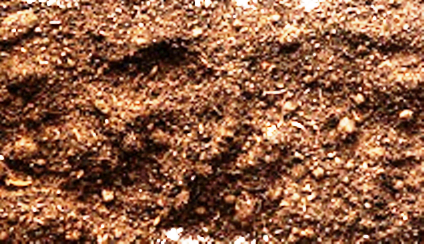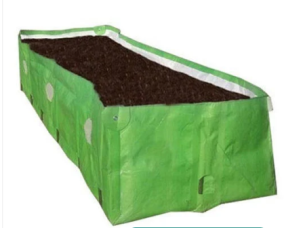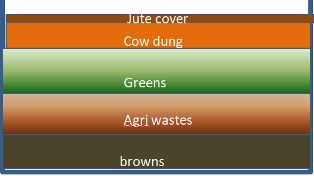
Introduction
Vermicompost is the product of the decomposition process using various species of worms, usually red wigglers, white worms, and other earthworms, to create a mixture of decomposing vegetable or food waste, bedding materials, and vermicast. This process is called vermicomposting.
Vermicast (also called worm castings (worm humus, worm manure, or worm faeces) is the end-product of the breakdown of organic matter by earthworms. These excreta have been shown to contain reduced levels of contaminants and a higher saturation of nutrients than the organic materials before vermicomposting.
Vermicompost is rich in microbial life which converts nutrients already present in the soil into plant- available forms. Unlike other compost, worm castings also contain worm mucus which prevent nutrients from washing away with the first watering and holds moisture better than plain soil.
Suitable Worm Species
- Eisenia fetida (Europe), the red wiggler or tiger worm. Closely related to Eisenia andrei, which is also usable.
- Eisenia hortensis (Europe), European night crawlers, prefers high C: N material.
- Eudrilus eugeniae (West Africa), African Night crawlers. Useful in the tropics.
- Perionyx excavatus (South and East Asia), blueworms. May be used in the tropics and subtropics.
- Lampito mauritii (Southern Asia), used locally. These species commonly are found in organic-rich soils throughout Europe and North America and live in rotting vegetation, compost, and manure piles.
All above are shallow-dwelling and feed on decomposing plant matter in the soil. They adapt easily to live on food or plant waste in the confines of a worm bin.
Composting worms are available to order online, from nursery mail-order suppliers or angling shops where they are sold as bait. They can also be collected from compost and manure piles.
These species are not the same worms that are found in ordinary soil or on pavement when the soil is flooded by water. Such worms are not suitable.
Climate and Temperature
There may be differences in vermicomposting method depending on the climate. It is necessary to monitor the temperatures of large-scale bin systems (which can have high heat-retentive properties), as the raw materials or feed stocks used can compost, heating up the worm bins as they decay and killing the worms.
If a worm bin is kept outside, it should be placed in a sheltered position away from direct sunlight and insulated against frost in winter.
Methods to make Vermicompost
Vermicomposting is easily adapted for small farms and household vegetable and flower garden. Main steps to produce vermi casting fertilizer are same in both methods.
For your kitchen garden:
Requires bins which one can make from any plastic or rubber or paint container, or buy ready made bins from agriculture stores. The bins have sufficient holes on the sides and in the bottom for aeration and excess water.
The vermicomposting steps start with first having carbon rich fluffy bedding which could be made of straw, wheat straw, newspaper shredding, cardboard shredding, cow manure, brown leaves and like. On top of this we release our worms. Now we put in a small quantity of our kitchen waste like vegetable leavings, fruit peels, coffee grounds, tea leaves, tea bags, corn husk, egg shells, bread, crackers, etc. but no cooked foot or meat. Sprinkle water.
Close tight the lid and put the bin where it would not be disturbed by roving cats or dogs. Composting requires moisture and darkness in the bin. To prevent worms from escaping, put bin in a lighted place as worms do not like light.
Check your bin regularly. You will need to add more kitchen waste (as food for worms) and carbon material till such time capacity is full. As it progresses take out vermi castings material out of the bin and add more carbon and food materials.
At the end of cycle, when full vermicompost can be seen to have been done, it is time to harvest worms from the composed material and start another bin. Harvesting should begin when the bedding and consumed food has turned a rich dark brown, with a consistency of coffee grounds. Waiting longer can result in a sludgy material that is difficult to harvest and may become anaerobic and odorous.
One commonly used method of harvesting vermicompost is to dump the bin onto a tarp in bright light, allowing the worms to burrow down to escape the light. Castings can then be separated by slowly scraping them away, pausing periodically to let the worms burrow further. Eventually, you are left with a pile of worms.
Another variation is to use two bins one on top of other. Worms from the top bin would escape to the bottom bin after food is exhausted in the top bin and continue eating and producing worm castings in the second bin. The top bin is removed. And another bin is now placed below the previous bottom bin.
Method for small Farms


- Determine a suitable place in a shady area and slightly elevated to deal with rains.
- A bin needs to be made about one meter wide and about 0.6 meter height. Length 3 meter to 15 meter depends on convenience,
- Place about six inches of dry brown material like leaves, pieces of twigs, cow manure, wheat straw, cardboard materials, newspaper cuttings etc. On top of this layer put greens and any agricultural greens. Layer it up till it is near to the top, on top put cow dung manure.
- Now put in worms at about 200 to 250 gms per cu.meter on the top layer.
- Sprinkle water on the top layer till the material is somewhat soggy,
- Cover with gunny bags so that no light can penetrate. Worms like darkness and they would burrow inside the layers.
- For protection put a shed on top of the beds,
- Keep on monitoring the moisture level and sprinkle water accordingly.
- Monitor the upper beds for vermi castings which can be removed and kept away.
- It will likely take 3 to 5 months depending on environment factors for full vermicompost process.
- At the end separate the worms.

Benefits
Soil
- Improves soil aeration.
- Enriches soil with micro-organisms (adding enzymes such as phosphatase and cellulase).
- Microbial activity in worm castings is 10 to 20 times higher than in the soil and organic matter that the worm ingests.
- Attracts deep-burrowing earthworms already present in the soil.
- Improves water holding capacity.
Plant growth
- Enhances germination, plant growth, and crop yield.
- It helps in root and plant growth.
- Enriches soil organisms (adding plant hormones such as auxins and gibberellic acid).
- Economic.
- Biowaste conversion reduces waste flow to landfills. Elimination of biowastes from the waste stream reduces contamination of other recyclables collected in a single bin (a common problem in communities practicing single-stream recycling).
- Creates low-skill jobs at local level.
- Low capital investment and relatively simple technologies make vermicomposting practical for less-developed agricultural regions.
Environmental
- Helps to close the “metabolic gap” through recycling waste on-site.
- Large systems often use temperature control and mechanized harvesting; however other equipment is relatively simple and does not wear out quickly.
- Production reduces greenhouse gas emissions such as methane and nitric oxide (produced in landfills or incinerators when not composted).
Uses
- Vermicompost can be mixed directly into the soil.
- Mixed with water to make a liquid fertilizer known as worm tea.
- The light brown waste liquid, or leachate, that drains into the bottom of some vermicomposting systems is not worm tea. It is best discarded or applied back to the bin when added moisture is needed for further processing.
The pH, nutrient, and microbial content of Vermicompost fertilizers vary upon the inputs fed to worms. Pulverized limestone or calcium carbonate can be added to the system to raise the pH.
Operational Precautions and Prevention
- Meat or dairy product attract rodents and flies and should not be used.
- In warm weather, fruit and vinegar flies breed in the bins if fruit and vegetable waste is not thoroughly covered with bedding. Thoroughly cover the waste by at least 5 centimeters of bedding.
- Maintaining the correct pH (close to neutral) and water content of the bin (just enough water where squeezed bedding drips a couple of drops) also avoids these pests.
- Worms generally stay in the bin, but may try to leave the bin when first introduced, or often after a rainstorm when the humidity outside is high. Maintain adequate conditions in the worm bin and put a light over the bin when first introducing worms.
- In order to avoid over-fertilization issues, such as nitrogen burn, vermicompost can be diluted as a tea 50:50 with water, or as a solid can be mixed in 50:50 with potting soil.
May like following also
Leave a Reply